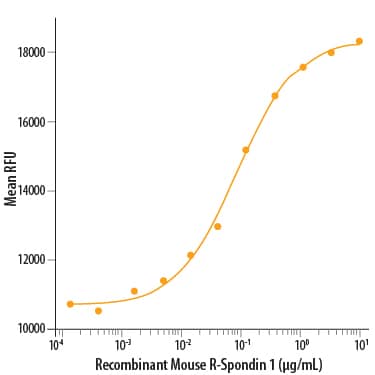Recombinant Mouse R-Spondin 1 Protein, CF Best Seller
R&D Systems, part of Bio-Techne | Catalog # 3474-RS

Key Product Details
Product Specifications
Source
Ser21-Gly209, with an N-terminal Met
Purity
Endotoxin Level
N-terminal Sequence Analysis
Predicted Molecular Mass
Activity
The typical ED50 is 50-200 ng/mL in the presence of 5 ng/mL recombinant mouse Wnt-3a.
Reviewed Applications
Read 5 reviews rated 4.6 using 3474-RS in the following applications:
Scientific Data Images for Recombinant Mouse R-Spondin 1 Protein, CF
Recombinant Mouse R-Spondin 1 Protein Bioactivity
Recombinant Mouse R-Spondin 1 (Catalog # 3474-RS) induces activation of beta-catenin response in a Topflash Luciferase assay using HEK293T human embryonic kidney cells. The ED50 for this effect is 50-200 ng/mL in the presence of 5 ng/mL of Recombinant Mouse Wnt-3a (Catalog # 1324-WN).Recombinant Mouse R-Spondin 1 Protein SDS-PAGE
1 μg/lane of Recombinant Mouse R-Spondin-1 was resolved with SDS-PAGE under reducing (R) conditions and visualized by silver staining, showing a single band at 24 kDa.Formulation, Preparation and Storage
3474-RS
| Formulation | Lyophilized from a 0.2 μm filtered solution in PBS. |
| Reconstitution |
Reconstitute at 250 μg/mL in sterile PBS.
|
| Shipping | The product is shipped at ambient temperature. Upon receipt, store it immediately at the temperature recommended below. |
| Stability & Storage | Use a manual defrost freezer and avoid repeated freeze-thaw cycles.
|
Background: R-Spondin 1
R-Spondin 1 (RSPO1, Roof plate-specific Spondin 1), also known as cysteine-rich and single thrombospondin domain containing protein 3 (Cristin 3), is a 27 kDa secreted protein that shares ~40% amino acid (aa) identity with three other R-Spondin family members (1, 2). All R-Spondins regulate Wnt/ beta-Catenin signaling but have distinct expression patterns (1-3). R-Spondin 1 competes with the Wnt antagonist DKK-1 for binding to the Wnt co-receptors, Kremen and LRP-6, reducing their DKK-1-mediated internalization (4). However, reports are mixed on whether R-Spondin 1 binds LRP-6 directly (4-6). R-Spondin 1 is expressed in early development at the roof plate boundary and is thought to contribute to dorsal neural tube development (3, 7). In humans, rare disruptions of the R-Spondin 1 gene are associated with tendencies for XX sex reversal (phenotypic male) or hermaphroditism, indicating a role for R-Spondin 1 in gender-specific differentiation (7, 8). Mutations in R-Spondin 1 are also linked with palmoplantar keratoderma, abnormal thickening of the skin on the palms of the hands and soles of the feet (7, 8). Postnatally, R-Spondin 1 is expressed by neuroendocrine cells in the intestine, adrenal gland and pancreas, and by epithelia in kidney and prostate (9). Injection of recombinant R-Spondin 1 in mice causes activation of beta-catenin and proliferation of intestinal crypt epithelial cells, and ameliorates experimental colitis (9, 10). Interest in R-Spondin 1 as a cell culture supplement has grown with the expansion of the organoid field. R-Spondin 1 is widely used in organoid cell culture workflows as a vital component that promotes both growth and survival of 3D organoids (11).
Structurally similar to other R-Spondins, R-Spondin 1 contains two adjacent cysteine-rich furin-like domains (aa 34-135) with one potential N-glycosylation site, followed by a thrombospondin (TSP-1) motif (aa 147-207) and a region rich in basic residues (aa 211-263). Only the furin-like domains are needed for beta-catenin stabilization (2, 12). A putative nuclear localization signal at the C-terminus may allow some expression in the nucleus (13). Mouse R‑Spondin 1 shares 98%, 94%, 94%, 93%, 92% and 88% aa identity with rat, human, horse, cow, goat and dog RSPO-1, respectively, within aa 21‑209.
References
- Chen, J-Z. et al. (2002) Mol. Biol. Rep. 29:287.
- Kim, K.-A. et al. (2006) Cell Cycle 5:23.
- Nam, J.-S. et al. (2007) Gene Expr. Patterns 7:306.
- Binnerts, M.E. et al. (2007) Proc. Natl. Acad. Sci. USA 104:14700.
- Nam, J.-S. et al. (2006) J. Biol. Chem. 281:13247.
- Wei, Q. et al. (2007) J. Biol. Chem. 282:15903.
- Kamata, T. et al. (2004) Biochim. Biophys. Acta 1676:51.
- Parma, P. et al. (2006) Nat. Genet. 38:1304.
- Kim, K.-A. et al. (2005) Science 309:1256.
- Zhao, J. et al. (2007) Gastroenterology 132:1331.
- Drost and Clevers. (2018) Nature Reviews Cancer 18:407.
- Kazanskaya, O. et al. (2004) Dev. Cell 7:525.
- Tomaselli, S. et al. (2008) Hum. Mutat. 29:220.
Long Name
Alternate Names
Gene Symbol
UniProt
Additional R-Spondin 1 Products
Product Documents for Recombinant Mouse R-Spondin 1 Protein, CF
Product Specific Notices for Recombinant Mouse R-Spondin 1 Protein, CF
For research use only

